

Ever since I saw The Good, The Bad and The Ugly I have loved spaghetti westerns. This movie doesn't seem to have the budget or the actors as the aforementioned movie, but it's got loads of grit! There are some great scenes (pulling the coffin and fight scenes) as well as some savage dialogue from the anti hero. If you're in the mood for a gritty old school spaghetti western then look no further.
... View MoreDjango is directed by Sergio Corbucci and it stars Franco Nero, José Bódalo, Loredana Nusciak, Ángel Álvarez and Eduardo Fajardo.Django (Nero), dragging a coffin behind him, saves a woman from some bandits and soon finds himself in the middle of war between two factions - which he may be able to use to his advantage.1966 was a stellar year for Spaghetti Westerns, Leone was putting the crown on his "Dollars" trilogy, Damiani produced a political firecracker and Sollima crafted one of the finest "manhunt" Oaters of this sub-genre. Then there is this, Django, a Pasta Western that is synonymous with the form.I fought for the North!Django is a treat, it's violent and cruel, funny and cheeky, and pleasing on the eyes and ears - so pretty much it contains all the best things that made the original wave of Spaghetti's so palatable. Undeniably it owes a "lot" to A Fistful of Dollars and Yojimbo, but it's still its own beast, a baroque Gothic piece of work that positively revels in nihilism. The graphic violence is wonderfully cartoonish, the iconography unbound, and in Nero - eyes likes chips of ice - the pic has one of the coolest and baddest men on the planet. Nusciak brings the sex and sizzle, coming off like a Spag Raquel Welch, whilst the villains are delightfully vile and scuzzy.The setting is superb, a muddy cold hell of a town with a brothel as the fulcrum of the piece. Naturally there's a cemetery, which will play host to some of that iconography mentioned earlier. Religion gets short shrift, racial prejudice given a caustic once over, while it's worth mentioning there's more than a hint of social realism pulsing away as Corbucci brings the blood and thunder. OK! It's light in plotting, and it's not even Corbucci's best film, but the stylised violence, the visuals and a cracking soundtrack easily take you away from the fodder of the story.It would spawn a multitude of rip-offs, name checks and influence a whole host of film makers, but this is the real deal. A Spag Western worth revisiting to see just when it was a sub-genre of quality, this before hundreds of poor band wagon jumpers began to soil the Spaghetti Western name. 8.5/10
... View MoreThis Spaghetti Western is yet another take on Kurosawas Yojimbo but the performance by Nero and the non-stop violence makes this a worthy film. Directed by Sergio Corbucci (The Great Silence, The White the Yellow and the Black, Navajo Joe). Corbuccis direction in Django is both artful and brilliant along with the screen writing. Franco Nero (Enter the Ninja, Die Hard 2, Camelot). is the only actor to capture the true and powerful emotion of Django. There's the action, there is a fist-fight, a gunfight, or some random act of sadism. The ear scene was violent. (Quentin Tarantino paid homage to this in Reservoir Dog). The fist smashing scenes. The movie was indeed violent for its time. The films graveyard shootout finale is very bleak n different. Cinematography by Enzo Barboni (The Five Man Army, A Long Ride from Hell, he directed Trinity Is STILL My Name, They Call Me Trinity). Edited by Nino Baragli (Once Upon a Time in America, Caligula, Salò, Once Upon a Time in the West, The Good, the Bad and the ugly). Music by Luis Enriquez Bacalov (The Gospel According to St. Matthew, Il Postino aka the postman). One of the best films of the genre to have not been directed by Sergio Leone. Full of more interesting and stylish scenes of action. More than thirty sequels to Django have been produced since 1966. Most of these films have nothing to do with Corbuccis original film.
... View MoreI first discovered this movie a while back, after seeing Quentin Tarantino's "Django Unchained". I loved DU, so when I heard there was more where it came from, I got really exited. After seeing the film, i must say that it was quite enjoyable and worth checking out. Franco Nero gives a great performance as Django, the bad-ass coffin-dragger. It's really different from Jamie Foxx's performance in DU, but that just makes it more interesting. It's nice to see that Tarantino didn't completely remake the original.The music is also great, and gives the film a great "feel". I wasn't aware that the music in "Django Unchained" was the same as in this one. So it came as a big surprise when the song Django popped up in the intro (which by the way, the intro is awesome and sets the mood perfectly). The music stays great throughout the film, and the songs never feel out of place.Something I was surprised by, was a particular scene in the movie. I wont spoil it, but I will say that the scene actually kinda shocked me. I can handle violent content, but i was just so surprised that they would allow it in 1966. Thats probably why it was banned in multiple countries.In conclusion, you should watch this film if you liked "Django Unchained". It's quite interesting seeing how much movies like these have changed, and how different from DU it is. But it's still very entertaining, and it helps that it has a great story. Check it out if you like westerns.
... View More